#Creative Worlds
Text
a list of 100+ buildings to put in your fantasy town
academy
adventurer's guild
alchemist
apiary
apothecary
aquarium
armory
art gallery
bakery
bank
barber
barracks
bathhouse
blacksmith
boathouse
book store
bookbinder
botanical garden
brothel
butcher
carpenter
cartographer
casino
castle
cobbler
coffee shop
council chamber
court house
crypt for the noble family
dentist
distillery
docks
dovecot
dyer
embassy
farmer's market
fighting pit
fishmonger
fortune teller
gallows
gatehouse
general store
graveyard
greenhouses
guard post
guildhall
gymnasium
haberdashery
haunted house
hedge maze
herbalist
hospice
hospital
house for sale
inn
jail
jeweller
kindergarten
leatherworker
library
locksmith
mail courier
manor house
market
mayor's house
monastery
morgue
museum
music shop
observatory
orchard
orphanage
outhouse
paper maker
pawnshop
pet shop
potion shop
potter
printmaker
quest board
residence
restricted zone
sawmill
school
scribe
sewer entrance
sheriff's office
shrine
silversmith
spa
speakeasy
spice merchant
sports stadium
stables
street market
tailor
tannery
tavern
tax collector
tea house
temple
textile shop
theatre
thieves guild
thrift store
tinker's workshop
town crier post
town square
townhall
toy store
trinket shop
warehouse
watchtower
water mill
weaver
well
windmill
wishing well
wizard tower
#worldbuilding#setting prompts#writer resources#writing inspiration#writing prompts#scene settings#writing reference#writing ideas#prompt list#creative writing#writing community#writer prompts#writing tips#world#fantasy world#fantasy worldbuilding#high fantasy#world building#epic fantasy#writing fantasy
87K notes
·
View notes
Text
I don't think many people realize how much they've been turned into a bunch of casually cynical jerks.
Someone may come to their parents and say "I want to write a book" and their parents will say "it's really hard to get published".
Someone might confide in their sibling and say "I want to sell my art on "x" platform" and that sibling will say "do you know how many people you'd be competing with? Do you know how many shops are even on that platform?"
I know a kid who once told his best friend "I think I wanna start a dnd podcast" and the friend was like "do you know what the word "oversaturation" means?"
Personally, I don't know why any of that matters? And even if it did, perhaps your response should be "Do it! Do it and see where it goes!"
80K notes
·
View notes
Text
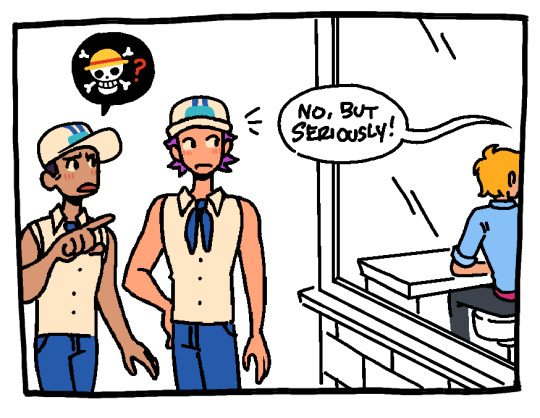
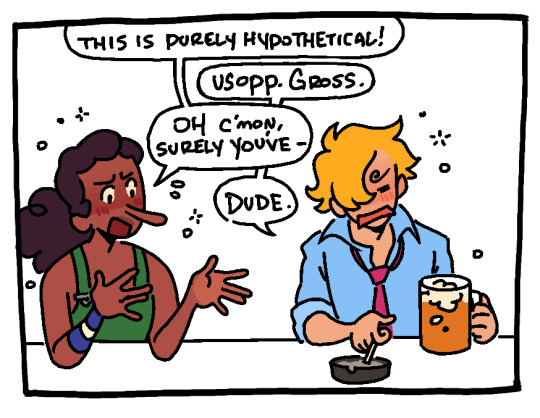
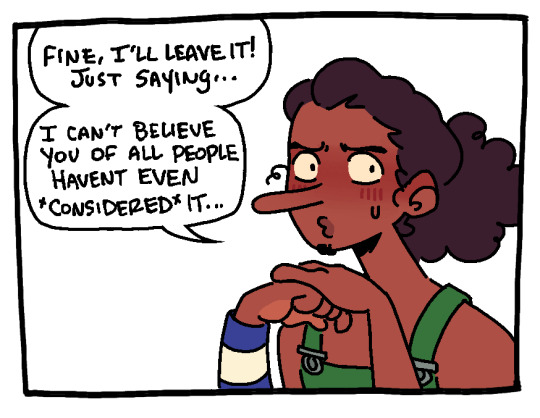

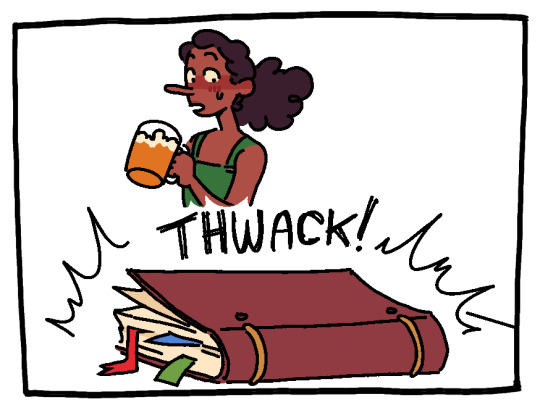

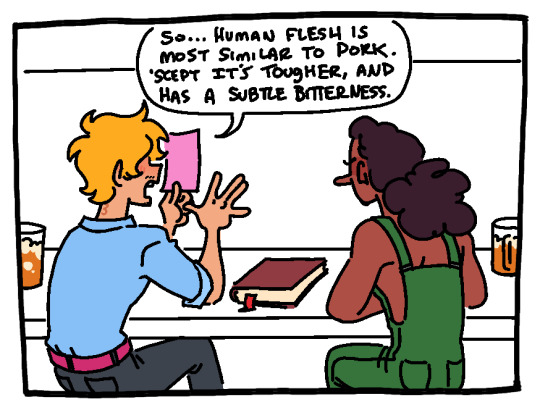
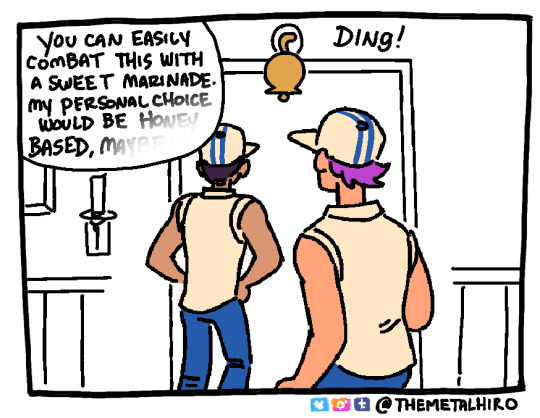
Someone else can deal with that.
#two comics in one day because its break week#we live in a world that sanji is labelled ‘blackleg’ instead of ‘cannibal cook’ the marines need to get more creative with their propaganda#metalhiro arts#one piece#one piece fanart#sanji#vinsmoke sanji#blackleg sanji#op sanji#usopp#god usopp#sogeking#sniper king#op usopp#one piece fancomic#strawhat pirates#straw hat crew
20K notes
·
View notes
Text
50 Character Personality Traits + Meanings (For writers, worldbuilders, and artists) Part 1
Adventurous - Enjoys trying new experiences and exploring the unknown.
Ambitious - Driven to succeed and achieve their goals.
Analytical - Tends to think critically and examine things in-depth.
Artistic - Highly creative and expresses themselves through artistic mediums.
Assertive - Confident in expressing their thoughts and feelings.
Caring - Shows compassion and concern for the well-being of others.
Charismatic - Has a natural charm and appeal that draws people in.
Clever - Able to come up with creative solutions and make astute observations.
Compassionate - Displays empathy and a desire to help those in need.
Confident - Believes in their own abilities and is self-assured.
Conscientious - Reliable, responsible, and attentive to detail.
Curious - Eager to learn new things and explore the world around them.
Cynical - Tends to be skeptical and distrustful of others' motives.
Dependable - Can be counted on to follow through on their commitments.
Determined - Persistent in pursuing their goals and overcoming challenges.
Diplomatic - Skilled at navigating social situations and resolving conflicts.
Eccentric - Displays unconventional or unusual behaviors and interests.
Empathetic - Able to understand and share the feelings of others.
Ethical - Guided by a strong moral compass and a sense of right and wrong.
Extraverted - Enjoys being around people and draws energy from social interactions.
Flexible - Adaptable to changes and open to trying new approaches.
Forgiving - Willing to let go of past hurts and give people second chances.
Friendly - Approachable and enjoys building positive relationships with others.
Grounded - Practical, down-to-earth, and focused on the present.
Hardworking - Diligent and dedicated in their efforts to achieve their goals.
Honest - Values truthfulness and integrity in their words and actions.
Idealistic - Driven by a vision of how the world should be and a desire to make a difference.
Imaginative - Possesses a rich inner world and creative problem-solving abilities.
Independent - Prefers to think and act for themselves without relying on others.
Indecisive - Struggles with making decisions and often second-guesses themselves.
Introverted - Finds energy and fulfillment in solitary activities and introspection.
Jealous - Experiences feelings of resentment or insecurity towards others.
Kind - Gentle, considerate, and thoughtful in their treatment of others.
Leaders - Able to inspire and guide others towards a common goal.
Logical - Approaches problems and decisions through a rational, analytical lens.
Materialistic - Highly values the acquisition of possessions and wealth.
Organized - Maintains order and efficiency in their personal and professional life.
Perfectionistic - Strives for flawlessness and can be overly critical of themselves and others.
Pessimistic - Tends to focus on the negative aspects of situations and expect the worst.
Resilient - Able to bounce back from setbacks and adapt to changes.
Risk-taker - Willing to take chances and step outside of their comfort zone.
Sarcastic - Uses irony and witty remarks to convey their thoughts and feelings.
Sensitive - Deeply affected by the emotions and experiences of themselves and others.
Stubborn - Unwilling to change their mind or compromise on their beliefs and opinions.
Suspicious - Inclined to doubt the motives and intentions of others.
Thoughtful - Considerate of the impact their words and actions have on others.
Timid - Shy, reserved, and hesitant to take risks or assert themselves.
Trustworthy - Reliable, honest, and worthy of confidence.
Unpredictable - Displays an element of surprise and spontaneity in their behavior.
Witty - Possesses a quick, clever, and humorous way of expressing themselves.
Hey fellow writers! I'm super excited to share that I've just launched a Tumblr community. I'm inviting all of you to join my community. All you have to do is fill out this Google form, and I'll personally send you an invitation to join the Write Right Society on Tumblr! Can't wait to see your posts!

#creative writing#writeblr#writing#thewriteadviceforwriters#on writing#writing tips#writers block#how to write#writers and poets#authors on tumblr#author#fiction#women writers#book writing#writer#writing advice#novel writing#writing blog#writer stuff#writers#writerscommunity#artists on tumblr#small artist#oc artist#world building#writersblock#writers on tumblr#helping writers#resources for writers#writerslife
3K notes
·
View notes
Text
A Workshop for Creating Magical/ Fictional Crystals: A Guide from a Geologist
Hi folks, its me, here to talk about fictional writing again! Today I'm just tackling the idea of magical stones/mana stones by looking at existing minerals today and some neat properties that they have, and how you can apply these things to a fictional world. The goal is mainly to help you if you are stuck trying to come up with a unique magic system, or a unique identification/characteristic of your mineral.
First Things First: Mineral Shapes

I am exhausted, petered out, down-right fatigued by seeing every mineral depicted with having the crystal structure of calcite and quartz. There are soooooo many cooler, more interesting crystal structures, don't you think you would stop and take a look at a perfect cube in nature? It is completely unsettling.
Second: Color
Color within minerals can either be really important, or not important at all! It is your choice to decide if color is going to be something that means something to your mineral. But what are some times when the color is important? Well.... there are some elements that are called chromophores, this classification just indicates that these elements, when present, will determine the color of whatever they are in. So, if you wanted to treat mana like a chromophore, you could say, "Oh everything that contains mana turns green!" This could mean that regardless of the mineral, if that mineral is a specific color, it means it contains mana. This concept is exciting because you can just stop here and use minerals that already exist! You can also use it as an indicator for a magical ore! Chromophores are typically metals, so if you are making a new metal weapon, making the ore of that metal a unique color would make a lot of sense!
However, your mineral can also just be every color of the rainbow like quartz and perhaps that's what makes identifying your mana stones elusive and create an illusion of scarcity that your character can solve.

There are other things that can change the colors of minerals, like radiation damage, and electron exchange, but I think that is beyond what would be helpful! So lets talk about some unique color properties that happen in nature that seem magical in the first place! Maybe you don't need to design a mana stone, but you want a unique gemstone that only the royal family passes down or something (IDK).
The first one is the alexandrite effect! This is where a mineral can change color in natural light vs. incandescent light. (the mineral itself is not changing, but the lights contain different amounts of different colors that then get absorbed by the stone). Even if you don't use electricity in your fictional world, you could have the colors change in the presence of light magic. This could create fun misunderstandings about what the mineral is reacting to!
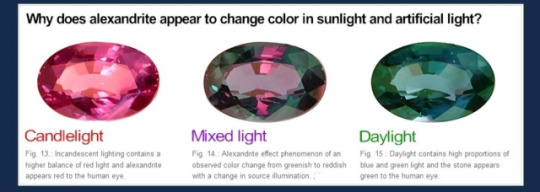
Pleochroism
Pleochroism is something that most minerals have, it is frequently used to help identify minerals in thin sections, however minerals are usually not pleochroic enough for it to be visible to the naked eye! Pleochroism is just a fancy name to describe the change in how light is absorbed based on the angle of the mineral! So if you scroll up to the first image where I showed a lot of crystal shapes, most of them have angles where they are longer and shorter! This will effect the way light travels in the crystal. Tanzanite is a popular mineral that does this.

Photochromism
This is when a mineral will change color (in a reversible way) when exposed to UV light (or sunlight), I am not going to go too into the details of why this is happening because it would require me to read some research papers and I just don't feel like it. The mineral that is best known for this is Hackmanite!

Alright! These are all the really cool color effects that might inspire you or maybe not, but now I am going to talk about how you might find your minerals within a rock!
When I see a lot of magical caves/mines, typically I see them with some variation of a geode honestly, but most minerals are not found like that! Now I am sure most of you guys have seen a geode, so I will not really talk about those, but I will talk briefly about porphyroblasts which is when the mineral grows larger than the minerals around it, this happens in metamorphic minerals!

sorry random stranger, but this is an image of garnets inside a finer-grained rock at gore mountain in New York!
Another way you might find minerals is in a pegmatite! This is when all minerals are really large! This is a formed from really slow crystalizing magma!
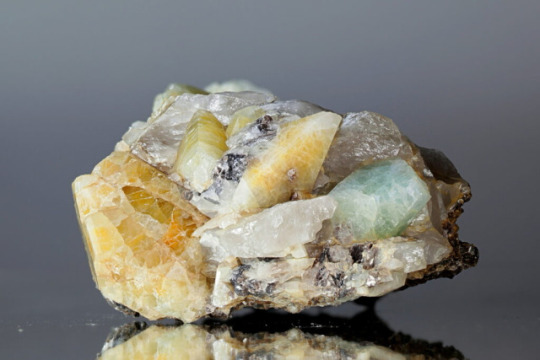

But something else to think about is that your mineral might just be massive, it doesn't have to have distinct crystals, it may be similar to jadeite where small grains grow together which leaves it looking smooth and seamless! A note about all of these is that you would have to mine into the rock to find these, there would not be any natural caves in these rocks! Caves are only ever really formed in limestones and maybe marbles (rocks that react with acid).

How can your characters identify these minerals?
Typically when you are out in the field you will look to see what type of rocks the minerals are found in (The overall texture of the rock will tell you how it formed). If you know how the rock formed, it will narrow down the amount of minerals you need to think about by quite a bit! Next, you are going to look closely at it and observe its crystal structure, does it have an obvious crystal? if so what is the general shape? If it is broken, how did it break? Did it fracture like glass or did it break along uniform planes. Some minerals have a thing called cleavage (breaks along planes of weakness). If a mineral exhibits this habit, it will again help narrow this down. Next we can look at color. Color can be misleading, because minerals like quartz can be any color imaginable, but minerals like olivine will always be green! The next thing your character can do is test for hardness, minerals all have a specific hardness that can help identify it as well.
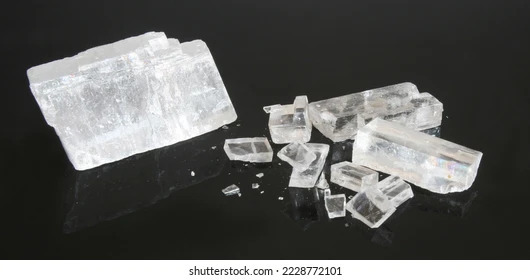
After you go through all of this, your mineral might have some special property! This could be magnetism, fluorescence, reactions to acid, or any of the color changing effects I mentioned above! Other than that, your character can take it back to a lab and do a number of things to identify it, but the most typical thing would be for them to make a thin section (very thin piece of the rock) and observe it under a cross polarized microscope!

On that note folks! I hope this helped in some way in thinking of new magic mineral properties! I have other guides that explore some different fictional worldbuilding issues you might run into, but if you have any topics you would like me to cover please that I haven't mentioned already, let me know!
#geology#rocks#creative writing#fictional world#worldbuilding#dnd#dnd worldbuilding#worldbuilding stuff#writing resources#info post#information#writing
5K notes
·
View notes
Text
Worldbuilding: Questions to Consider
Government & authority:
Types of government: What type of government exists (monarchy, democracy, theocracy, etc.)? Is it centralised or decentralised?
Leadership: Who holds power and how is it acquired (inheritance, election, divine right, conquest)?
Law enforcement: Who enforces the laws (military, police, magical entities)?
Legal system: How are laws made, interpreted, and enforced? Are there courts, judges, or councils?
Laws:
Criminal laws: What constitutes a crime? What are the punishments?
Civil laws: How are disputes between individuals resolved?
Cultural norms: How do customs and traditions influence the laws?
Magic/supernatural: Are there laws governing the use of magic or interaction with supernatural beings?
Social structure:
Class/status: How is society divided (nobility, commoners, slaves)? Are there caste systems or social mobility?
Rights & freedoms: What rights do individuals have (speech, religion, property)?
Discrimination: Are there laws that protect or discriminate against certain groups (race, gender, species, culture)?
Economy & trade:
Currency: What is used as currency? Is it standardised?
Trade laws: Are there regulations on trade, tariffs, or embargoes?
Property laws: How is ownership determined and transferred? Are there inheritance laws?
Religion/belief systems:
Religious authority: What role does religion play in governance? Are religious leaders also political leaders?
Freedom of religion: Are citizens free to practice different religions? If not, which are taboo?
Holy laws: Are there laws based on religious texts or teachings?
Military & defense:
Standing army: Is there a professional military or a militia? Who serves, and how are they recruited?
War & peace: What are the laws regarding war, peace treaties, and diplomacy?
Weapons: Are there restrictions or laws regarding weapons for civilians? What is used as a weapon? Who has access to them?
Technology & magic:
Technological advancements: How advanced is the technology (medieval, steampunk, futuristic, etc.)?
Magical laws: Are there regulations on the use of magic, magical creatures, or artifacts?
Innovation & research: How are inventors and researchers treated? Are there laws protecting intellectual property?
Environmental/resource management:
Natural resources: How are resources like water, minerals, and forests managed and protected, if at all?
Environmental laws: Are there protections for the environment? How are they enforced? Are there consequences for violations?
Cultural & ethical considerations:
Cultural diversity: How does the law accommodate or suppress cultural diversity?
Ethics: What are the ethical foundations of the laws? Are there philosophical or moral principles that underpin them?
Traditions vs. change: Does the society balance tradition with progress? How?
Happy writing ❤
Previous | Next
#writeblr#writing#writing tips#writing help#writing resources#creative writing#worldbuilding#fantasy worldbuilding#fantasy writing#fantasy world#deception-united
2K notes
·
View notes
Text
It never ceases to amaze me how brilliant fan fiction writers are, like, you take bits of something and can turn it into such brilliance and create crazy good plot lines with so much depth and layers and come up with all these ideas, like, literally blows my mind every time. The level of creativity is stunning
Never stop
#and I get to live inside these worlds and tbh I don’t wanna return#like I be scrolling here and wondering how people come up with these ideas and it’s amazing#encourage creativity#fan fiction#AO3#archive of our own#writing#vee talks
8K notes
·
View notes
Text
on worldbuilding, and what people think is going on
there is one facet of fantasy worldbuilding that is, to me, the most interesting and essential but i don't see it come up in worldbuilding guides or writing prompts or anything, and that is the question of:
what do the inhabitants of your world believe about how the world works, and how are they wrong? a lot of fantasy media will set up their cosmology, gods, magic systems, planar systems, concepts of the afterlife, &c., and proceed as though the inhabitants of the world know and understand them.
from someone whose entire academic career is focused on studying human culture in various regions and time periods, with a focus on belief systems (religion, occultism, mythology, folklore): that sort of worldbuilding is unrealistic and missing out on so much fun.
people are always seeking new understanding about how the world works, and they are mostly wrong. how many models of the solar system were proposed before we reached our current one? look at the long, turbulent history of medicine and our various bizarre models for understanding the human body and how to fix it. so many religions and occult/magical traditions arise from people disagreeing with or adapting various models of the world based on new ideas, methods, technologies. many of them are wrong, but all of them are interesting and reflect a lot about the culture, beliefs, values, and fears of the people creating/practising them.
there is so much more to the story of what people believe about the world than just what is true.
to be clear: i think it's fine and important for the author to have a coherent explanation for where magic comes from or who the gods are, so they can maintain consistency in their story. but they should also be asking what people in the world (especially different people, in different regions/nations and different times) think is happening when they do magic, or say a prayer, or practise medicine, or grieve their dead. it is a rich vein for conflict between individuals and nations alike when two models of the world disagree. it is fascinating how different magic systems might develop according to different underlying beliefs.
personally, i think it is the most fun to spawn many diverse models of the world, but give none of them the 'right' answer.
(bonus points if you also have a thriving academic system in the world with its own theory, research, and discourse between factions! as an academic, it is very fun to imagine fictional academic debate over the topics i'm worldbuilding. sometimes i will be working out details for some underlying mechanic of the world and start imagining the papers being written by scholars researching it)
3K notes
·
View notes
Text
What to give a fuck about,while writing your first draft!
I`ve posted a list about things you don´t need to give a fuck about while writing your first draft. Here are things you NEED TO CARE about! (in my opinion)
Your Authentic Voice: Don't let the fear of judgment or comparison stifle your unique voice. I know it´s hard,but try to write from your heart, and don't worry about perfection in the first draft. Let your authenticity shine through your words.
Your Story, Your Way: It's your narrative, your world, and your characters. Don't let external expectations or trends dictate how your story should unfold. Write the story you want to tell.
Progress Over Perfection: Your first draft is not the final product; it's the raw material for your masterpiece. Give a fuck about making progress, not achieving perfection. Embrace imperfections and understand that editing comes later.
Consistency and Routine: Discipline matters. Make a commitment to your writing routine and stick to it.
Feedback and Growth: While it's essential to protect your creative space during the first draft, be open to constructive feedback later on. Giving a f*ck about growth means you're willing to learn from others and improve your work.
Self-Compassion: Mistakes, writer's block, and self-doubt are all part of the process. Give a f*ck about being kind to yourself. Don't beat yourself up if the words don't flow perfectly every time. Keep pushing forward and remember that writing is a journey.
Remember, the first draft is your canvas, your playground. Don't bog yourself down with unnecessary worries.
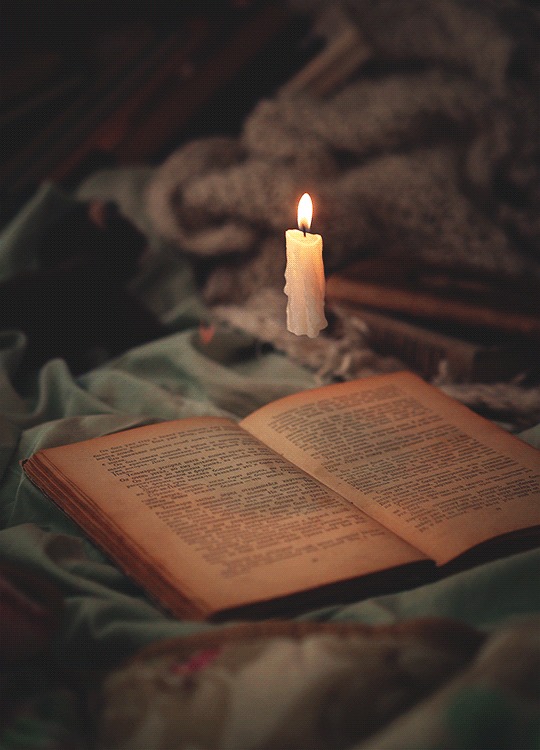
#writing#writblr#writing advice#writers block#just writer things#creative writing#fanfiction writing#writing motivation#writeblr#original writing#writing reference#writing tips#writers on tumblr#writing resources#writing tip#writing encouragement#writing community#writers#world building#point of view#editing#character creation#dialogue#mine.#words#writingtips#writingadvice
4K notes
·
View notes
Text
World Building Checklist
Have you ever started writing a story and realized your world has a bunch of unexplained shit and you have to fill in the gaps as you go? Me too, buddy. Me too. Here’s a checklist so that you can fully flesh out your world to the max. (I’m dying)
How does Time work? (Minutes, hours, days, the daylight cycle, years, ect.)
Species (if Fantasy. Will probably make another post on this.)
Countries, Nations, Tribes, ect. (nationalities/ races. Will probably make another post on this.)
The geography of the world (draw a map. Doesnt have to be good. Just for a general idea.)
Rivalries between races (includes prejudice, racism, ect.)
Religions
Technology
The Magic system. (Will probably make a whole other post on this.)
animals, plants, ect.
The sky: Sun, Moon(s), Stars, Constellation, Are there rings? (If the planet has rings)
Educations system
Government system
Politics
Methods of transport (Vehicles)
Medicine
Can’t really think of anything else. If you have more to add then reblog and add to the list! :) bye bee
#writing advice#how to write#creative writing#writers on tumblr#writing#writeblr#world#world building#fantasy worldbuilding#fantasy writing#fantasy tips#Fantasy world building tips#Writing tips#HEAVENLYRAIN’S WRITING TIPS
3K notes
·
View notes
Text
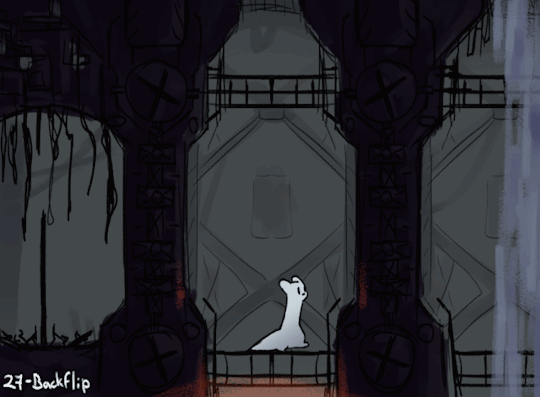
Day 27. The (I think) universal experience
#rain world#rain world fanart#gif#fast gif#gif warning#fast gif warning#anyone else thinks backflip is kind of a weird prompt??#there's not that much you can do with that word I think#mayhaps I'm just uncreative. these days have been rough on my creativity. BUT WE'RE STAYING STROKG BABEY!!! DAY 27 IS GOING TO LOOK AWESOME#i hope.
3K notes
·
View notes
Text

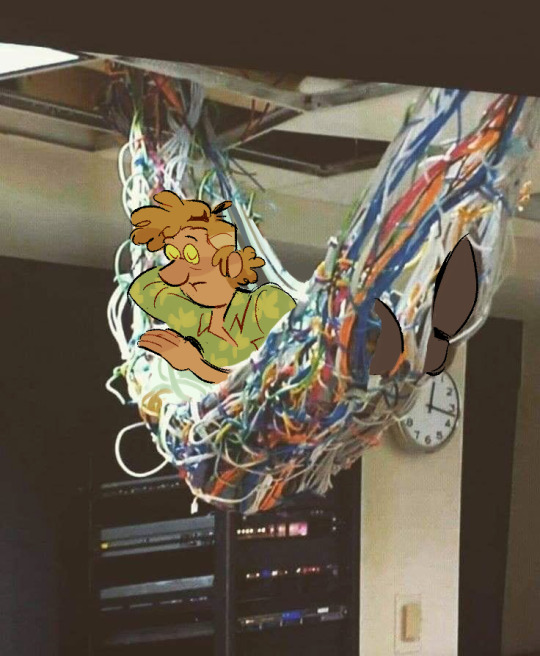


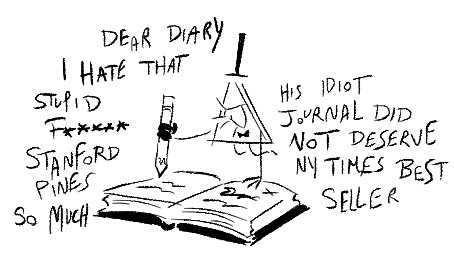


If you have the same hyperfixation for too long they put money on your head and baby I'm frontlining America's most wanted
bonus parallel fidds sprites

#gravity falls#fiddleford mcgucket#stanford pines#fiddauthor#stanley pines#a better world au#going to start actually tagging that now#lab creations#I haven't been very creatively motivated lately so I've just been busy playing pokemon but here's some of the last gf stuff from nov-dec#when I get my energy back. I would like to work on my comic#key phrase being 'would like to'#maybe I'll stick to that
2K notes
·
View notes
Text
Want to worldbuild like a pro??
(📖 Master tips and everything I know📖)
Hello writers! You don't know how to worldbuild? Don't know where to start explaining the world you have created? Don't worry, you are in the right place! I have been there myself, and after many research (and even more trial and error) I have put together a list of the best worldbuilding tips I have encountered, and also created some of my own. (I know the first one is kind of overheard, but trust me).
Don't start right away with worldbuilding. A long paragraph about how your world works and its history might overwhelm new readers. A lot of other writers suggest waiting and learning about the world at the same time the protagonist does, or if that doesn't work for your story, dropping bits of information while the story moves forward. However, if you want to give a sense of how your world works from the start...
Exposition through action. This is my favorite method, and it helps a lot if you don't want to pause your story to info dump about the world you have created. Instead, this method relies on explaining the world and its dynamics while you continue with the narrative, briefly. For example: "As always, you couldn't see any trees in the meadow. The king had ordered years ago to cut each one of them because of a prophecy that foretold that the last dragon egg would lay in an oak."
Use expressions that reference normality or routines. In the last point, we used "as always", but there are tons of expressions you could use in your writing. This helps the reader understand what is the norm in this new world and what things are common, to later detect something that is not within that norm (or sometimes just to understand the world and its traditions better).
Use flashbacks when necessary. If you need to explain a very specific or detailed topic, I suggest using a flashback scene, that will help the reader understand with the narration and dialogue, instead of just explaining it to them. It makes for a more dynamic learning experience. But, at the end...
Do whatever will intrigue you. Some readers even like info dumps, and there is not one correct way to show your world. If it would make you curious, go and do it, wether people say it's correct or not. There are a lot of successful books that randomly stop to explain something about the world, and there is nothing wrong with that if you like it.
Hope you find this list useful, and as always happy writing :)
Also, if you are interested in tips or more examples of a specific topic, you can always leave a question in my ask. I'd be glad to answer it!!
Other tips for writers: previous | next
#writeblr#writing#writer#writers#writers on tumblr#writerscommunity#writers of tumblr#creative writing#current wip#world building#worldbuilding#tips for writers#tips#writing tips
2K notes
·
View notes
Text
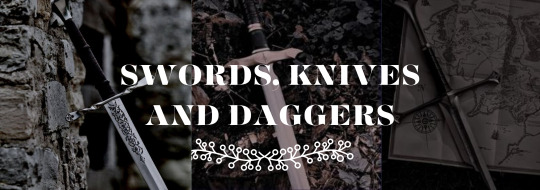
Writing Weapons (2): Knives and Daggers
Dagger vs. Sword
In many situations, daggers might be more plausible than a sword fight.
Dagger are eaiser to carry and conceal, lighter, faster, good for spontaneous action, suicide bids, self-defense and assassination.
Dagger vs. Knife
No clear distinction; terms used interchangeably
Dagger is more for thrusting with 2 sharp edges
Knife is more for cutting (slashing) with 1 sharp edge
Concealment
Carried in a leather sheath on the belt
Can be concealed under a cloak, in a bodice (sheath sewn into the bodice), in a boot, behind hari ornaments
Bodice daggers (popular in the Renaissance) had no cross guards.
Connotations
Beside its combat value, the dagger has lots of emotional and sexual symbolisms.
The closeness need to attack with a dagger creates intense personal connection. They are often used in fights where emotions are running high: gang warfare, hate crime, vengeance.
Due to its shape and the fact that it's usually worn on a belt made it a symbol of virility in many cultures and periods.
Sometimes it was the hilt rather than the blade: like in the case of bollocks daggers with two...balls on either side of the hilt.
Fighting Techniques
Stabbing:-
The dagger with long, thin blades are made to stab a vital organ like the kidneys, liver, bowel, stomach or heart.
Stabbing directly at the chest seldom works, since the blde may glance off the ribs. Position the dagger below the ribcage and drive it upwards, through the diaphragm and into the lungs. If the sword is long enough and your fighter is a professional, you can get to the heart.
If no professional, just keep going for the stomach and you'll get one of the vital organs eventually.
Slashing:-
When describing a slash wound, show a lot of blood streaming, or even spurting.
Slashing dagger fights are bloody - show your MC's hands getting slick with blood, grip on the weapon slipping.
The aim is to cut the opponent's throat or cut tendoms, muscles, or ligaments to disable. Slashing the muscles in the weapon-wielding arm is the most effective; insides of the writst or back of the knee is also critical.
Assassinations:-
Show good knowledge of the humna antatomy
Use a stabbing dagger
A single, determined, calculated and efficient stroke, probably below the ribs.
Self-Defense:-
Disable the attacker by slashing their weapon-wielding hand (elbow or wrist)
Quick, multiple stabs wherever the MC can get the blade to land; the attacker won't give time for careful positioning
If the blade is too short to do any significant damage, maek up for this by stabbing so ast that the pain and blood loss distracts the opponent.
Vegeance and Hatred:-
Someone who is motivated by raging emotions will stab the victim repeatedly, even after he is already dead.
The attacker may stab or salsh the victim's face, disfiguring it.
Contemporary street fights and gang warfare usually involves these.
Duels:-
If both fighters are armed with daggers, include wrestling-type moves as they try to restrict each other's weapon hand.
Show them trying to disable each other by slashing insides of writes, elbows, the back of the knees, etc.
Dagger + Sword
If the character is expecting a fight, they can hold a sword in their right hand, and a dagger in their left to fight with both
Sword + mace combination also common.
Blunders to Avoid:
Direct stabbing at the chest wouldn't work.
Hero cannot cut his bread with a stabbing sword
adapted from <Writer's Craft> by Rayne Hall
#writing#writers and poets#writers on tumblr#helping writers#creative writing#writeblr#let's write#poets and writers#creative writers#resources for writers#dagger#fight scene#description#action scene#writer#write#fantasy#medieval fantasy#high fantasy#fantasy world#writer on tumblr#ao3 writer#writer problems#writer stuff#writer community#writer things#author#writing practice#writing prompt#writing inspiration
1K notes
·
View notes
Text
Geology of Natural Disasters and How to write them into your fictional universe.
So, you want to write about a natural disaster to advance your plot and torture your players/characters even more? Let me tell you how, accurately.
I feel like unless it is a volcano, natural disasters are a pretty slept on plot drivers, and some of them are really cool and unique! Today, I will talk to you about land slides, earthquakes (And earthquake related disasters), and volcanoes.
Landslides: Probably one I see the least in stories, but one that would be incredibly interesting to write into a plot where they believe in curses. Landslides can happen along ocean bluffs, slightly hilly areas, and highly mountainous areas, this means it is something that can happen in most landscapes. But what can trigger a landslide? Mostly all you need to trigger a landslide could be just abnormally large amounts of rain, excessive deforestation (with a little bit of rain), or an earthquake. If you don't want to use deforestation or an earthquake as a catalyst, a really cool indicator that the land is slipping and may be prone to a collapse is J hooked trees.

This indicates that there is soil creeping slowly over time, and it may lead to a major landslide.
2. Earthquakes: Probably one of the easiest things to write, earthquakes can happen anywhere, but they are most common in places that are tectonically active areas. There are about three types of environments you can expect earthquakes to be common. The first is just rugged mountains, if your landscape looks like this, you should write in earthquakes. Associated hazards could be landslides, avalanches, and large falling rocks.
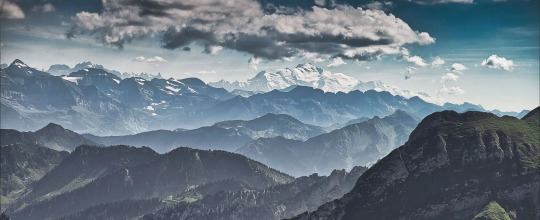
The next landscape could be a thin mountain range, next to the ocean, very scenic, but very dangerous. Essentially, I am describing a subduction zone environment.

Earthquakes in these areas could equal a couple different associated disasters. Scenario one: A very large earthquake happens, and the ocean begins to recede. This is a tsunami, enough said. If you are writing a tsunami though, please, please, do not write it as a large wave, thank you. Also, a common way people are hurt by tsunami's are from them going into the ocean because they don't understand a tsunami is going to happen.
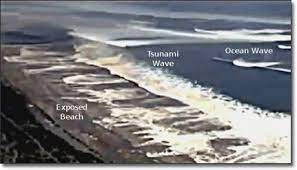
Scenario two: A large earthquake happens, your characters are in a valley and suddenly the ground begins to liquify as the ground shakes, once the shaking stops, the ground becomes solid like nothing ever happened, except everything has suddenly sunk into the now hard ground. This is called liquefaction and it typically happens in areas that have loose dirt or lots of saturated soil.
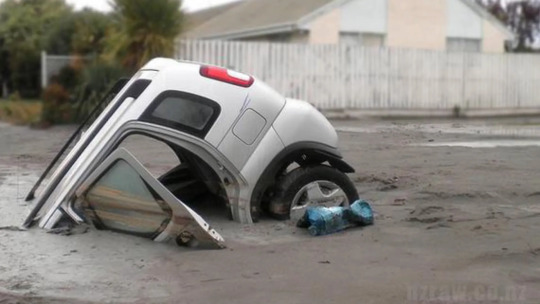
Scenario three: There are a lot of small earthquakes, they do not cause a lot of damage, but you begin to notice that one of the isolated mountains has a plume rising. Earthquakes can indicate lava moving underground and the filling of magma chambers.
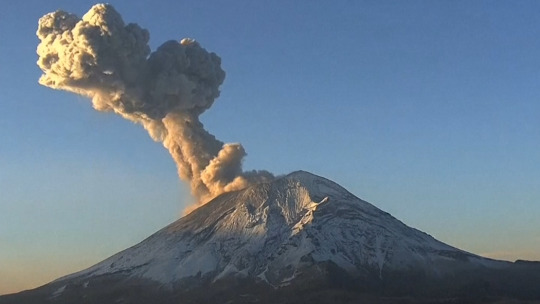
The next environment that can host lots of earthquakes would be regions that have a lot of really deep valleys and small mountain ranges (not cone volcanoes), but overall seems pretty flat.
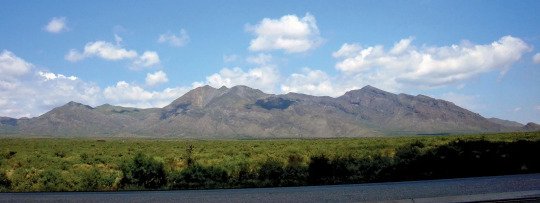
This indicates a transform fault like the San Andreas. If you want to hint at there being earthquakes in the area, you can show fence posts that are suddenly several feet out of line at a dilapidated farm or something similar.
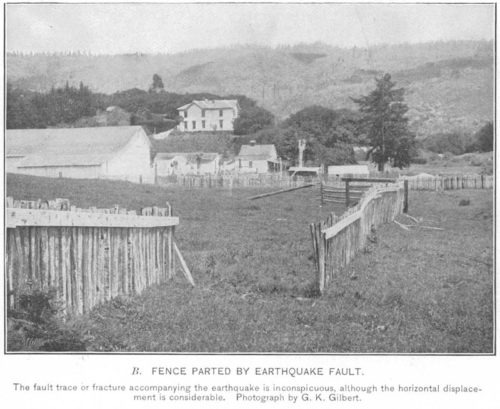
(These earthquakes are different because they are cased from sideways movement, not an up-and-down movement this hint can only be used for this environment). Volcanoes would not be found here, but liquefaction and landslides could still occur here.
4. Volcanoes: If you thought earthquakes had a lot of information, volcanoes do too. First you have to ask yourself, what kind of volcano you want to have, what kind of eruption style? So lets break down the kind of eruptions you can have and what their landscapes look like. Hawaiian Shield volcano: This will produce a smooth fast lava, the landscape typically is pretty flat, but there will be small cones and the rocks can have a ropey or jagged texture and the rocks will be almost exclusively black to dark red.

Stratovolcanoes: These will be solitary mountains, typically, that look like perfect cones (Picture shown in earthquake section). These will have large ash cloud eruptions and pyroclastic flows, they may have some lava, but typically most damage is done from the pyroclastic flows (think Pompeii). Some hints of these, other than describing the cone features (which can be hidden by other mountains), would be to talk about petrified wood! Trees can get fossilized in the ash and I imagine it would be very strange to find this rock that clearly looks to be a piece of wood, but its a rock. Subcategory- Calderas: Used to be a large stratovolcano, but they erupt so explosively that the entire cone collapses and creates a basin.

There are a lot of kinds of volcanoes out there, so forgive me for just putting an infographic and then talking to you about these really rare types of eruptions that I feel like people should know about.
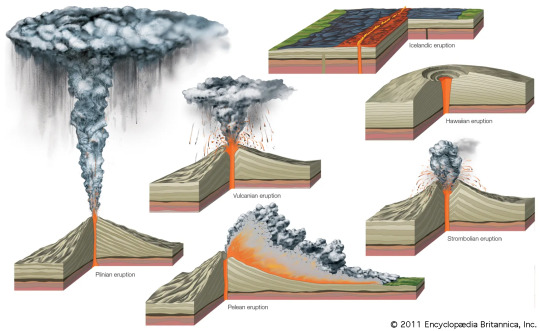
Okay lets talk about blue lava (kind of) and black lava

You will notice the lava is still red in the middle of this image, during the day these would look like a normal eruption, but at night the burning sulfur would make it appear blue. Some cool features other than this, would be that any water in the area would become very acidic and burn the skin due to sulfuric acid. This would again be really cool if you are trying to describe a 'cursed' land.
Black lava: This happens only in the east African rift I believe, but it is a carbonatite lava, but if you are writing in a rift valley (where the continent is tearing apart to form a new ocean) this might be a cool feature. The lava will cool white and will quickly erode, it makes for a very alien landscape!

Anyway as always, this is supposed to be an introductive guide for the basics of writing geology to create cool landscapes/features into dnd or fictional universes, if you are a geologist please understand my oversimplification of tectonics, I didn't want people to run away.
#geology#rocks#stem#dnd#dnd worldbuilding#worldbuilding stuff#fictional world#worldbuilding#fictional writing#writing resources#creative writing
5K notes
·
View notes
Text
"the creator said in a reddit thread -" "the official twitter account posted that -" "the actors confirmed in a livestream that -"
i don't care and that's not real to me. put it in the text.
#for fun stuff like 'this character's favorite food is meatballs' im like cool but for worldbuilding and stuff? nah#i do understand some nuance with writers or w/e who were held back by corporate teams on confirming a character is gay or something#and wanting to talk about their hopes and intentions#but this is rly about the opposite with creative teams wanting the points for diversity or plot choices#or world building without putting it in the actual story#esp if its bc they just didn't want to piss off bigots or can't write well#sw giving backstory on the sith fleet situation in a TWEET will always be infamous to me#not st#doctor's log
1K notes
·
View notes